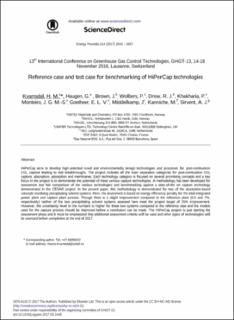| dc.contributor.author | Kvamsdal, Hanne Marie | |
| dc.contributor.author | Haugen, Geir | |
| dc.contributor.author | Brown, Jock | |
| dc.contributor.author | Wolbers, Patrick F. | |
| dc.contributor.author | Drew, Richsrd J. | |
| dc.contributor.author | Khakharia, Purvil | |
| dc.contributor.author | Monteiro, Juliana Garcia Moretz-Sohn | |
| dc.contributor.author | Goetheer, Earl L.V. | |
| dc.contributor.author | Middelkamp, Jan | |
| dc.contributor.author | Kanniche, Mohamed S. | |
| dc.contributor.author | Sirvent, Antoni Julià | |
| dc.date.accessioned | 2020-12-22T13:35:31Z | |
| dc.date.available | 2020-12-22T13:35:31Z | |
| dc.date.created | 2018-02-14T18:09:29Z | |
| dc.date.issued | 2017 | |
| dc.identifier.citation | Energy Procedia. 2017, 114 2642-2657. | en_US |
| dc.identifier.issn | 1876-6102 | |
| dc.identifier.uri | https://hdl.handle.net/11250/2720814 | |
| dc.description.abstract | HiPerCap aims to develop high-potential novel and environmentally benign technologies and processes for post-combustion CO2 capture leading to real breakthroughs. The project includes all the main separation categories for post-combustion CO2 capture, absorption, adsorption and membranes. Each technology category is focused on several promising concepts and a key focus in the project is to demonstrate the potential of these various capture technologies. A methodology has been developed for assessment and fair comparison of the various technologies and benchmarking against a state-of-the art capture technology demonstrated in the CESAR project. In the present paper, this methodology is demonstrated for two of the absorption-based concepts involving precipitating solvent systems. Here, the assessment is based on energy efficiency penalty for the total integrated power plant and capture plant process. Though there is a slight improvement compared to the reference plant (0.5 and 7%, respectively) neither of the two precipitating solvent systems assessed here meet the project target of 25% improvement. However, the uncertainty level in the numbers is higher for these two systems compared to the reference case and the models used for the capture process should be improved before a conclusion can be made. The HiPerCap project is just starting the assessment phase and it must be emphasized that additional assessment criteria will be used and other types of technologies will be assessed before completion at the end of 2017. | en_US |
| dc.language.iso | eng | en_US |
| dc.publisher | Elsevier | en_US |
| dc.rights | Attribution-NonCommercial-NoDerivatives 4.0 Internasjonal | * |
| dc.rights.uri | http://creativecommons.org/licenses/by-nc-nd/4.0/deed.no | * |
| dc.subject | benchmarking | en_US |
| dc.subject | precipitating solvents | en_US |
| dc.subject | absorption | en_US |
| dc.subject | post-combustion | en_US |
| dc.title | Reference case and test case for benchmarking of HiPerCap technologies | en_US |
| dc.type | Peer reviewed | en_US |
| dc.type | Journal article | en_US |
| dc.description.version | publishedVersion | en_US |
| dc.rights.holder | © 2017 The Authors. Published by Elsevier Ltd. This is an open access article under the CC BY-NC-ND license
(http://creativecommons.org/licenses/by-nc-nd/4.0/). Peer-review under responsibility of the organizing committee of GHGT-13. doi: 10.1016/j.egypro.2017.03.1448 | en_US |
| dc.source.pagenumber | 2642-2657 | en_US |
| dc.source.volume | 114 | en_US |
| dc.source.journal | Energy Procedia | en_US |
| dc.identifier.doi | 10.1016/j.egypro.2017.03.1448 | |
| dc.identifier.cristin | 1565305 | |
| cristin.unitcode | 7401,80,3,4 | |
| cristin.unitname | CO2 innfangningsprosesser | |
| cristin.ispublished | true | |
| cristin.fulltext | original | |
| cristin.qualitycode | 1 | |

